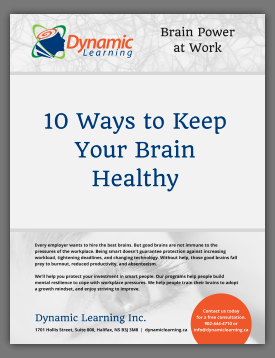These turbulent times do make it more difficult to focus on what you really want to do. Assuming you have set some goals for 2021, let’s work with your brain to actually achieve them.
My goal for 2021 is to do more of what makes me happy and a lot less of what makes me unhappy.
Here are some tips to teach your brain how to focus your attention, then concentrate that attention until you are in the groove where your entire cognitive effort is engaged in one important task.
Train Your Brain to Get the Important Things Done First
You need to understand how to harness and direct your fantastic brainpower. Your pre-frontal cortex (just behind your forehead) is where all your goal-oriented thinking happens. It is often called the Executive Function.
Focusing this part of our brain on important tasks takes effort. When we do concentrate our attention, extra blood rich in oxygen and glucose flows to the relevant neurons, helping us concentrate even more.
However, our cave-dweller past can upset our plans. As far as your brain is concerned, it has two functions: to keep you safe and to conserve your energy.
- In order to keep you safe, your ancient brain is very threat sensitive, very fast, and always on. It is automatic, which means you can’t turn it off.
- In order to conserve your energy, your brain uses fast, short-cut thinking habits and is quite impulsive.
Your brain needs to conserve energy because, although it is only 2% of your body weight, it uses 20% of your energy. And when you want to use your pre-frontal cortex, it uses 80% of that precious 20%. So this fast-thinking, automatic part of your brain sets up resistance when you try to concentrate. It uses mind wandering to find distractions.
To teach our brains to focus more predictably, we need to set up conditions that reduce distractions. Try some of these tips over the next couple of weeks.
- Prepare your thinking. Remind yourself of the value of reaching your goal, which will take consistent, persistent effort.
- Set a time limit on how long you intend to focus on the task. Thirty minutes may be enough to fine-tune existing ideas; 90 minutes may be better for innovative thinking.
- Arrange your space to minimize distractions. If you are in an office, an unoccupied board room or office where others can’t find you is ideal. Working from home is difficult if you have family around. If you cannot isolate yourself, wear headphones or earplugs, turn off all pinging, flashing, vibrating electronic alerts – emails, calendars, and cell phones. You may need to cover lights and/or pull down the blinds.
- Accept that your brain will kick up repeated distractions to tempt you into a little mind wandering. While you are working on focusing your attention, your brain will try to do what it does more often, which is to happily jump from one thought to another. When you persist in bringing your attention back to the important task you are working on, eventually, the rest of your brain will quiet down.
- Recognize that learning to concentrate is a skill. As you reduce external distractions and train your brain to focus more quickly and completely, you will experience the ‘flow’ of being fully engaged and productive in your work more easily and more often.
- Don’t wait until you are ‘in the mood’. We are rarely in the mood to do something challenging until we have already started. Once you have used the previous steps, your mood will improve and you will be more likely to get into and stay in ‘the flow’.
- Don’t respond to distractions. As soon as you shift your attention, blood flows to different parts of your brain and muscles, and it’s harder to get back on task. Congratulate yourself for resisting the distraction, promise yourself a reward for staying on task, and celebrate your improved concentration.
- Don’t expect to concentrate for 1.5 hours at first. Start with 10- to 30-minute sessions, so your brain has a chance to learn your new process. Your brain cannot store the oxygen and glucose that your bloodstream brings to your pre-frontal cortex. Every time you give in to distraction, your blood flow is re-directed away, and that tires your pre-frontal cortex. It’s like draining the battery of your cell phone when it has too many programs running.
A Checklist to Maximize Your Focus
- Clarify your goals.
- Prioritize your top 3 tasks according to your goals.
- Have a tidy desk with your top 3 to-do’s prominently displayed.
- Do everything you can to block interruptions and distractions.
- Mute phone and email.
- Close the door, put up a Do Not Disturb sign.
- Wear noise-cancelling earphones.
- Have a “Get Started” ritual – one you can use repeatedly to develop a habit.
- Concentrate on one task for 20 to 50 minutes.
- Reward yourself for good work, stand, stretch, and settle down again.
- Concentrate again for 20 to 50 minutes.
- Again reward yourself, stand and stretch.
- Recharge your battery.
- Coffee, tea, water
- Healthy snack
- Short walk
- Work on your top priorities early in the day, rewarding yourself as you proceed.
- You can expect to be able to build up to 2 to 4 hours of focused, concentrated work on most days. Spend the rest of the time on less demanding tasks. Before the end of your workday, prioritize your top 3 tasks according to your goals for the next day.


